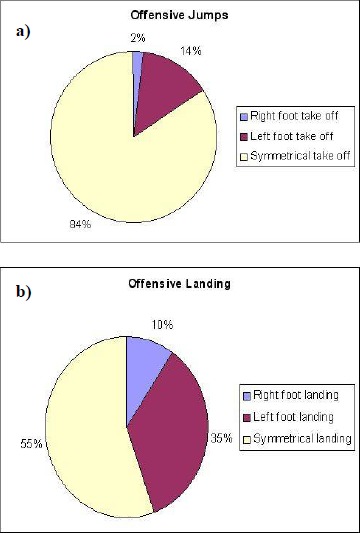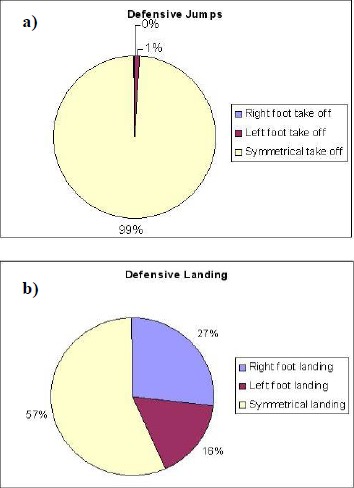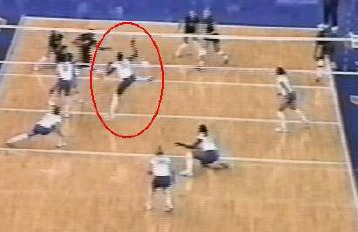Abstract
Volleyball has become one of the most widely played participant sports in the world. Participation requires expertise in many physical skills and performance is often dependent on an individual’s ability to jump and land. The incidence of injury in volleyball is similar to the rates reported for sports that are considered more physical contact sports. Though the most common source of injury in volleyball is the jump landing sequence, little research exists regarding the prevalence of jumping and landing techniques. The purpose of this study was to quantify the number of jumps performed by female volleyball players in competitive matches and to determine the relative frequency of different jump-landing techniques. Videotape recordings of two matches among four volleyball teams were analyzed for this study. Each activity was categorized by jump type (offensive spike or defensive block) and phase (jump or landing). Phase was subcategorized by foot use patterns (right, left, or both). Each of the players averaged nearly 22 jump-landings per game. Foot use patterns occurred in unequal amounts (p < 0.001) with over 50% of defensive landings occurring on one foot. Coaches, physical educators, and recreation providers may utilize the findings of this inquiry to help prevent injuries in volleyball.
Key Points.
The incidence of injury in volleyball is nearly equivalent to injury rates reported for ice hockey and soccer.
Most injuries in volleyball occur during the jump landing sequence, but few data exist regarding jump landing techniques for elite female players.
Our data indicate that the vast majority of jumps utilize two feet, but approximately half of landings occur with only one foot.
Coaches, physical educators, and recreation providers may utilize the findings of this inquiry to prevent possible injuries in athletes, students, or those who participate in volleyball for recreational purposes.
Key words: Knee injury, jumping technique, female, leap, frequency
Introduction
The sport of volleyball has continued to increase in participation since its inception over one hundred years ago. Volleyball has become one of the most widely played participant sports in the world with over 200 million players (Aagaard et al., 1997; Briner and Kacmar, 1997). The number of participants rivals the number of soccer participants (250 million) reported by the Federation Internationale de Football Association (Dvorak et al., 2000). Another indication of the worldwide appeal of all forms of volleyball was the inclusion of beach volleyball as an Olympic sport in 1996. Potential reasons for the popularity of volleyball are that the sport requires a minimal amount of equipment and individuals can participate throughout their lives at a variety of skill levels. Women’s athletics is one segment of the sporting community that has seen particular support for volleyball.
Universities and colleges in the United States currently sponsor 972 women’s volleyball teams (National Collegiate Athletic Association, 2002). Volleyball has the third highest participation rate among high school girls in the United States boasting 400,000 participants taking part each year (National Federation of State High School Associations, 2002). The increased interest in volleyball has been accompanied by a growing concern in the sports medicine community regarding the incidence of injuries (Schafle, 1993). Surprisingly, the incidence of acute injury (e.g. ligament sprains) in volleyball is similar to the rates reported for sports that are considered more physical contact sports. In fact, the incidence of injury in volleyball is nearly equivalent to those observed in ice hockey and soccer (Aagaard et al., 1997). The inherent risk for injury in volleyball is a result of its dynamic and ballistic nature and the fact that a spiked volleyball may travel at speeds as high as 145 km·h-1 (90 mph) (Briner and Kacmar, 1997). Successful participation in the sport requires expertise in many physical skills and performance is often dependent on an individual’s ability to propel themselves into the air during both offensive and defensive maneuvers. These movements include the jump serve, spike, and block. During the execution of a jump serve or a spike, the player jumps high into the air and strikes the ball at the highest point of their jump in an effort to propel the ball rapidly down towards the opposing side of the net. Defensively, front row players defend against spikes by jumping into the air with their hands raised in an effort to impede the offensive attack. Unlike offensive jumps, defensive jumps are not maximal vertical jump efforts. Elite female players are instructed to jump to a height that will keep their heads below the level of the top of the net. The rationale for this strategy is two fold. First, decreased vertical jump height shortens the amount of time a defender spends in the air and provides additional time in contact with the ground for maneuvering. Second, the lower jump heights utilized defensively provide protection for the face and head of the players.
It is important to consider that spikes and blocks are not only jumps, but jump-landing sequences. In particular, the landing phase requires dissipation of the kinetic energy generated during the jump. Newtonian mechanics dictates that increases in jump height (most prevalent in elite volleyball players) must be accompanied by a proportional increase in the kinetic energy that must be properly absorbed to avoid injury (Dufek and Zhang, 1996). These landings often result in the creation of ground reaction forces on the order of five times body weight (Adrian and Laughlin, 1983). The deleterious effects of these forces may be compounded when considering that a front row player may jump and land many times during a regulation match.
The mechanisms and frequencies of injury in volleyball are intriguing and well documented. The jump-landing sequence is the most common source of injury in volleyball (Briner and Kacmar, 1997). In fact, blocking and spiking are linked with over 70% of volleyball injuries (Watkins and Green, 1992). More specifically, the landing techniques used in volleyball can potentially be related to lower extremity energy absorption and likelihood of injury (Dufek and Zhang, 1996). Stacoff and colleagues, (1988) found an initial vertical impact force of approximately 1 to 2 BW at forefoot touchdown for males performing a block. Heel contact resulted in a second peak force ranging between 1 BW to 7BW. The authors observed that the height of the jump was less important than knee angle in predicting the magnitude of the force with increased knee extension producing more force during landing. Thus, technique plays an important role during landing in volleyball.
Jumping and landing movements are fundamental features of many sporting activities and have received considerable research attention. Previous research on landing has concentrated on the implications of the impact and the resulting loads placed on the body as well as the injury potential of various landing situations. For example, Kovacs and colleagues, (1997) indicated that the landing technique used by the individual (forefoot vs. heel-toe landing) has significant implications regarding the forces transmitted to the body and the body’s ability to dissipate these forces. Accordingly, the jumping and landing techniques utilized by volleyball players may influence their likelihood of injury during the jump landing sequence. Ferretti et al., (1992) hypothesized that the high number of jumps and the likelihood of losing balance due to deviations in jumping technique are the primary causes of injury during volleyball (Ferretti et al., 1992). The vast majority (90%) of volleyball injuries occur in the lower extremity with the knee joint being particularly vulnerable (Gerberich et al., 1987). Knee injuries are of particular importance because they are associated with more lost time from sports participation than other injury sites (Solgård et al., 1995).
Though it is known that knee injuries are a common problem in volleyball and that technique influences the magnitude of the forces transmitted to the lower extremity during landings, little research exists regarding the prevalence of jumping and landing techniques in elite female volleyball. Thus, the purpose of this study was to quantify the number of jumps performed by elite female volleyball players in competitive matches and to determine the relative frequency of different jumping techniques. A secondary purpose of this investigation was to discuss implications for physical education professionals, coaches, and researchers.
Methods
Videotape recordings of two matches among four NCAA Division IA female volleyball teams were analyzed for this study. All four teams were considered elite (ranked in the top 25 in the United States) at the time the matches were played (fall of 2000). Each match lasted four games. The team closest to the video camera was studied during each game. Thus, two games from each match were analyzed per team because the teams switch sides after every game. The games were played on a hard court with conventional six player teams. Front row players perform the majority of volleyball jumps and landings. Thus, front row players were the primary focus of this study. However, offensive spikes that were executed from the back were also included in the analysis.
Each videotape was played back manually (frame by frame) in order to accurately observe several aspects of the jumping activity. Each activity was categorized by jump type (offensive or defensive) and phase (jump or landing). Offensive jumps were primarily spikes and defensive jumps were mostly blocks, but other front row jumps (designed to deceive the opponent) occurred and were included in the coding process. These activities were chosen because they are most likely to result in injury. Phase was further subcategorized by foot use patterns (right foot, left foot, or both feet). Each factor was scored in a categorical manner (right foot =1, left foot = 2, both feet =3). Jumps were categorized as ‘both feet’ if the right and left feet came off the ground simultaneously. If one foot left the ground one frame (33ms) ahead of the other then the jump was scored as unilateral (right or left). A similar convention was used to code landings. Landings were categorized as ‘both feet’ if the right and left foot contacted the ground in the same video frame. Due to the categorical nature of the data, a nonparametric technique (chi-square) was chosen as the analysis tool. More specifically, the chi-square is designed to evaluate whether the number of cases in each category is different from what would be expected on the basis of chance (Thomas and Nelson, 1990). Four chi-square analyses were performed to determine whether foot use patterns (right, left, or both) varied according to jump type (offensive or defensive) and phase (jump or landing) (α=0.05). Because three foot use patterns were possible, it was assumed that 33% of each jump type and phase would occur with the right foot, 33% for the left, and 33% for both feet.
Results
During the four game matches, 1087 (484 offensive and 603 defensive) jumps and subsequent landings were evaluated. Twenty-five different front row players performed the jumping activities. On average, each of the players studied executed nearly 45 jumps and subsequent landings for the two games analyzed. The maximum number of jump-landing sequences observed over a two game period was 73.
The relative frequency of foot use patterns occurred in unequal amounts during offensive jumps and landings. The majority (408) of offensive jumps were performed using both feet (χ2(2) = 576.1, p < 0.001). Sixty-seven offensive jumps were performed with the left foot and the remaining nine were performed with the right. Similarly, most offensive landings (269) were performed bilaterally with both feet making contact with the ground simultaneously (χ2(2) = 153.2, p < 0.001). Of the unilateral landings, approximately 35% (168) involved left foot first landing while 10% (47) utilized a right foot first technique. See Figure 1.
Figure 1.

Frequency of foot use strategies: (a) offensive jumps; (b) offensive landings.
Foot use patterns were also distributed unequally for defensive jumps and landings. Both feet were used to propel the players into the air in over 99% (597) of defensive jumps (χ2(2) = 1170.3, p < 0.001). Only four defensive jumps were performed using the left foot and two with the right. Similarly when landing from a defensive jump, the bilateral two foot pattern was most prevalent (342) followed by right foot landings (163) and left foot landings (98) (χ2(2) = 158.9, p < 0.001). Results appear in Figure2.
Figure 2.

Frequency of foot use strategies: (a) defensive jumps; (b) defensive landings.
Discussion
This study was designed to evaluate the jumping and landing techniques utilized by expert female volleyball players. Specifically, the number of jumps performed by elite female volleyball players in a competitive match was quantified and the relative frequency of different jumping techniques was determined. The combinations of the jump-landing strategies occurred in disproportionate amounts.
Nearly all offensive and defensive jumps performed by elite female volleyball players are executed using both feet. Jumping with both feet affords the athlete a wide and stable base of support for force production and maximal vertical leap performance. Accordingly, very few injuries occur during the jump phase of blocks or spikes. Conversely, nearly half of all landings in elite women’s volleyball utilize a unilateral landing technique. This observed trend may be especially important when one considers that the most frequent mechanism of knee injury in volleyball is a unilateral landing from a jump (Kovacs et al., 1997). The relatively high number of unilateral landings could lead to a loss of balance and subsequent injury. Schafle, (1993) stated that an occasional unilateral landing increases the likelihood of knee ligament derangement. Mechanically speaking, these unilateral landings jeopardize the landing limb because a single limb must dissipate the energy created by two limbs during the jump phase. As shown in Figure 3, this situation may lead to the high-risk lower extremity alignment referred to as the “position of no return” (Ireland, 1999). This dangerous orientation during landing is characterized by the following traits: a forward flexed and rotated back, hip adduction and internal rotation, knee flexion and valgus positioning, external tibial rotation, and a lack of control of the opposite foot. In this position, the muscles that would normally help the athlete remain erect cannot function properly because they are working at a mechanical disadvantage, which leads to a greater predisposition for injury (Ireland, 1999).
Figure 3.

Unilateral landing resulting in the “position of no return.”
Interestingly, the majority of unilateral landings resulting from offensive jumps take place with the left leg and the majority of unilateral landings resulting from defensive jumps are performed with the right leg. This result may be related to the fact that the majority of the population (volleyball players included) is right handed. For example, when a right-handed player spikes the ball, their goal is to reach as high as possible with the right hand in order to hit the ball down. As a result, the trunk is flexed to the left. This lateral flexion raises the right side of the body and can lead to a left foot first contact upon landing. The relatively high number of right foot first contacts by defensive players could be in response to defending right-handed spikers. Handedness and arm swing activity were not recorded for the present study, but should be addressed in future research.
Preventing injuries is difficult in volleyball because it is inherently a high-risk sport relative to the knee joint. Strengthening of the entire lower extremity is a possible intervention that would allow the jumper to dissipate the energy of landing through the muscles instead of the bones and ligaments (Schafle, 1993). Another preventative strategy proposed by Briner and Kacmar, (1997) is that athletes should be advised of the importance of landing techniques and the significance of landing with a slightly flexed knee and plantar flexed foot. This positioning at contact would provide a large range of motion for the lower extremity joints to utilize to dissipate the ground reaction forces. This coincides with the work of Zhang et al., (2000) who reported that the knee joint extensors and plantar flexors function as the primary energy dissipaters during landing.
Physical training (relative to strength and technique) may be the most practical and effective modality for preventing injuries related to landing from a jump. The positive effects of training have been reported by Hewett and colleagues, (1996). In their study, female athletes participated in plyometric jump training for 6 weeks. After training, maximum landing forces during a block were reduced by 22%. In addition, adduction and abduction moments were decreased by 50%. These improvements could prevent athletes from reaching the “position of no return” and subsequently decrease the incidence of injury in this population. Interestingly, no change in vertical leap performance was detected after training. Thus, it appears that training can improve landing mechanics without decreasing performance. Concerning technique, athletes who regularly perform landings and are exposed to the concurrent large impact forces should concentrate on performing landings using a toe-heel contact patterns with greater knee flexion whenever possible and whenever practical (Dufek and Bates, 1990). Although this technique requires greater muscular strength, it may be more advantageous relative to injury prevention. However, this can present difficulties strategically because landing with a more flexed knee may prevent the player from executing their next movement in a timely manner. Researchers, physicians, therapists, trainers, coaches, and athletes should focus on factors that are controllable in an effort to reduce injuries in volleyball. The most promising possibilities appear to be increasing strength, improving conditioning, and modifying jump-landing techniques.
Conclusions
The results of this study may provide practitioners with some important implications in regard to volleyball landing techniques. However, the data collected here should be interpreted with caution. Although the basic rules and strategies of volleyball competition do not vary greatly, male players, back row players, individuals of lesser expertise, or those playing under different conditions (e.g. sand volleyball or teams with fewer players) may utilize different jumping and landing techniques. Future research should focus on different populations and playing conditions. Despite this limitation, coaches, physical educators, and recreation providers may utilize the findings of this inquiry to prevent possible injuries in athletes, students, or those who participate in volleyball for recreational purposes. Designing practice routines and sequences that teach athletes to land bilaterally seem especially important for volleyball coaching professionals. Coaches that place an emphasis on landing properly in intrasquad contests and games would likely reduce the incidence of injury or joint stress. These results may provide physical educators with proper teaching sequences and cues when teaching volleyball units. The findings are likewise important for elementary school physical educators because teaching proper landing technique as a fundamental skill facilitates proper skill execution by children as they develop. The results of this study may be particularly useful to recreation providers since volleyball is one of the most played recreation sports worldwide. Finally, coaching, teaching, and recreational practitioners that utilize the findings of this inquiry may help reduce the incidence of lower extremity injury in volleyball participants.
Biographies

Mark D. TILLMAN
Employment
Ass. Prof. in the Department of Exercise & Sport Sciences at the Univ. of Florida, Gainesville, Florida, USA
Degree
PhD
Research interests
Jump-landing mechanics and mechanisms of anterior cruciate ligament injuries as well as functional outcomes of various therapeutic and surgical interventions.
Email: mtillman@hhp.ufl.edu

Chris J. HAAS
Employment
Postdoctoral Fellow in the Department of Neurology, Emory University College of Medicine, Atlanta, Georgia, USA
Degree
PhD
Research interests
Neuromechanical control of movement in healthy anddiseased populations.
Email: chass@emory.edu

Denis BRUNT
Employment
Prof. and Chair in the Department of Physical Therapy, East Carolina University, Greenville, North Carolina, USA
Degree
EdD, PT
Research interests
The initiation of movement from quiet stance.
Email: bruntd@mail.ecu.edu

Gregg R. BENNETT
Employment
Ass. Prof. in the Department of Recreation, Parks, and Tourism, Univ. of Florida, Gainesville, Florida, USA
Degree
EdD
Research interests
Sponsorship effectiveness and the action sports industry segment.
Email: gbennett@hhp.ufl.edu
References
- Aagaard H., Scavenius M., Jorgensen U. (1997) An epidemiological analysis of the injury pattern in indoor and in beach volleyball. International Journal of Sports Medicine 18, 217-221 [DOI] [PubMed] [Google Scholar]
- Adrian M.J., Laughlin C.K. (1983) Magnitude of ground reaction forces while performing volleyball skills. : Biomechanics VIII-B. Champaign, IL: Human Kinetics; 903-914 [Google Scholar]
- Briner W.W., Kacmar L. (1997) Common injuries in volleyball: Mechanisms of injury, prevention and rehabilitation. Sports Medicine 24, 65-71 [DOI] [PubMed] [Google Scholar]
- Dufek J.S., Bates B.T. (1990) The evaluation and prediction of impact forces during landings. Medicine & Science in Sports & Exercise 22, 370-377 [PubMed] [Google Scholar]
- Dufek J.S., Zhang S. (1996) Landing models for volleyball players: A longitudinal evaluation. Journal of Sports Medicine and Physical Fitness 36, 35-42 [PubMed] [Google Scholar]
- Dvorak J., Graf-Baumann T., Peterson L., Junge A. (2000) Risk factors and incidence of injuries in football players. American Journal of Sports Medicine 28, S1-S2 [PubMed] [Google Scholar]
- Ferretti A., Papandrea P., Conteduca F., Mariani P.P. (1992) Knee ligament injuries in volleyball players. American Journal of Sports Medicine 20, 203-207 [DOI] [PubMed] [Google Scholar]
- Gerberich S.G., Luhman S., Finke C., Pries,t J.D., Beard B.J. (1987) Analysis of severe injuries associated with volleyball activities. The Physician and Sportsmedicine 15, 75-79 [Google Scholar]
- Hewett T.E., Stroupe A.L., Nance T.A., Noyes F.R. (1996) Plyometric training in female athletes: Decreased impact forces and increased hamstring torques. American Journal of Sports Medicine 24(6), 765-773 [DOI] [PubMed] [Google Scholar]
- Ireland M.L. (1999) Anterior cruciate ligament injury in female athletes: epidemiology. Journal of Athletic Training 34(2), 150-154 [PMC free article] [PubMed] [Google Scholar]
- Kovacs I., Tihanyi J., DeVita P., Racz L., Barrier J., Hortobagyi T. (1997) Foot placement modifies kinematics and kinetics during drop jumping. Medicine & Science in Sports & Exercise 31, 708-716 [DOI] [PubMed] [Google Scholar]
- National Collegiate Athletic Association (2002) In: Schools sponsoring NCAA sports 2002. Available from URL: http://www.ncaa.org [Google Scholar]
- National Federation of State High School Associations (2002) In: Top 10 girls programs 2002. Available from URL: http://www.nfhs.org [Google Scholar]
- Schafle M. D. (1993) Common injuries in volleyball: Treatment, prevention and rehabilitation. Sports Medicine 16, 126-129 [DOI] [PubMed] [Google Scholar]
- Solgård L., Nielsen A.B., Moller-Madsen B., Jacobsen B.W., Yde J., Jensen J. (1995) Volleyball injuries presenting in casualty: A prospective study. British Journal of Sports Medicine 29, 200-204 [DOI] [PMC free article] [PubMed] [Google Scholar]
- Stacoff A., Kaelin X., Stuessi E. (1988) The impact in landing after a volleyball block. : Biomechanics XI-B. Amsterdam, the Netherlands: Free University Press; 694-700 [Google Scholar]
- Thomas J.R., Nelson J.K. (1990) Nonparametric techniques. : Research Methods in Physical Activity. 2nd edition Champaign, IL: Human Kinetics; 179-183 [Google Scholar]
- Watkins J., Green B.N. (1992) Volleyball injuries: A survey of injuries of Scottish national league male players. British Journal of Sports Medicine 26135-137 [DOI] [PMC free article] [PubMed] [Google Scholar]
- Zhang S., Bates B.T., Dufek J.S. (2000) Contributions of lower extremity joints to energy dissipation during landings. Medicine & Science in Sports & Exercise 32, 812-819 [DOI] [PubMed] [Google Scholar]


